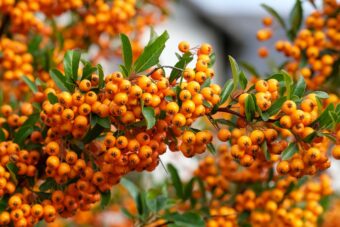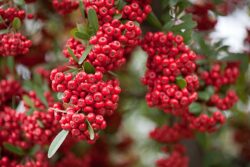In this article, we will discuss how to grow the attractive berry-forming shrub of Pyracantha, the Firethorn, in containers. Pyracantha is from the Greek words ‘Pyr’ meanings ‘Fire’ and ‘Akanthes’ translating to ‘Thorn’. Hence, its common name of Firethorn. Pyracantha is a genus of 8+ species of large, evergreen shrubs that have long and very sharp thorns. It is a member of the Rosaceae (the Rose) family, which is found extensively from Southwest Europe to Southeast Asia.

At first glance, it may look like a cotoneaster, which is not surprising as they belong to the same family. The difference is that the leaves are serrated and Pyracantha has thorns, whilst Cotoneasters do not, Typically Pyracantha grow up to 4.5m tall but dwarves do exist.
They are not grown for the small, lanceolate, evergreen leaves and most certainly not for the vicious thorns they produce. They are not even grown for the dainty white flower they produce. No, they are grown for the numerous berries they produce in autumn and winter. The small flowers that appear in late spring/early summer consist of 5 petals and have many yellow stamens.
The flowers are followed by fruits known as pomes that are red, orange or yellow, depending on the species and variety grown. The fruits start to develop in late summer.
The pomes that are produced can be consumed, especially the pulp, but it is flavourless. The seeds, on the other hand, are mildly poisonous and cause mild gastric-intestinal issues if consumed in large amounts.
The pulp can be made into edible jelly and make a good source of winter feed for birds.
One thing that must be stressed is that Pyracanthas are quick growing and will need to be pruned regularly to keep them in check.
Find out how to grow Pyracantha in containers in this article.
GROWING PYRACANTHA IN CONTAINERS
Pyracantha can be grown as a standalone specimen plant or grown against a wall to offer some support. If you do this, make sure it is 50cm from the wall or fence to avoid drying the area under the base.
First, chose a large container (greater than 40cm in diameter) that has plenty of drainage holes at the bottom. To this container, add a 2cm layer of gravel to help drain any excess moisture. On top of this, add up to 5cm of the top rim with a multipurpose compost to which a handful of slow-release fertilizer has been added.
Dig a hole at the centre of the container slightly bigger than the root ball it came in the original pot that you purchased the plant in. Drop the plant in so that the top of the root ball is at the same level as the top surface of the compost within the container. Backfill with the growing media so that no vacant spaces remain, using more compost if you need to.
Firm the compost around the roots and water well until it emerges from the drainage holes. Apply a thin layer of woodchips mulch to suppress weeds and conserve moisture.
THE BEST GROWING CONDITIONS
Place your Pyracantha in a sunny location where it will be at its best. Will take partial shade but the berries really shine in the sun.
Water frequently in the first couple of years to help establish the plant, especially when the surface of the compost feels dry to the touch. After that only water when 5cm below the top surface of the compost feels dry to the touch, especially so in hot, dry spells.
In early spring, feed with a slow-release, general-purpose fertilizer at the manufacturer’s recommended dosage. Follow this with a new application of compost to ‘Top Up’ the surface of the container.

To prune your Pyracantha, it is a good idea to wear very thick gloves and goggles to protect your hands and eyes.
Pyracantha tends to flower on the previous year’s growth, so when pruning retain as much two years old wood as possible. For pot-grown, free-standing shrubs, all you need to do is remove all damaged, diseased and unwanted branches in mid-spring.
For this grown against a wall or trellis, you will need to prune to make the pomes more visible. In spring, cut out any shoots growing outwards. Waiting until after flowering will let you minimize the loss of fruiting wood.
In late summer, all side shoots that come from the main branches, starting where the pomes are forming, can be trained. At this time, you can attach new shoots to wires and trellis to extend the display. Best done when the shoots are still flexible.
Pyracantha is best propagated via semi-ripe cuttings, taken in summer and grown on in a cold frame, or hardwood cuttings taken in autumn and left open to the outdoors. Allow to grow on before planting out the following year.
Can be grown from seed but this is not recommended as it needs many months of cold stratification for the seed to germinate and it will not breed true to the cultivar you took the seed from.
PESTS AND DISEASES
Pyracanthas are not without their problems. First, they can suffer from Pyracantha scab, a fungal disease that will result in the leaves and flowers failing, and the fruits being disfigured.
The leaves develop black spots and soon fall to the ground. Shrubs can be defoliated quite substantially and young shoots may look burnt. Any flowers will shrivel turn brown and do not fruit. The pomes will be disfigured and also have black spots.

The best way to prevent it from happening in the first place is by removing fallen leaves and burning them. You will need to cut out any infected stems to good wood. Flowering will be affected the following year, which is expected. An alternative is to grow disease-resistant varieties like ‘Teton’. Although it may not be effective you can use any fungicides to see if it helps. Follow what is written in the instructions.
Fireblight is a bacterial infection that gives firethorns a scorched appearance. What will be observed is that the flower will wilt and die at flowering time. The shoots will also shrink. The wood will also turn a reddish-brown when the bark is peeled back to show the wood has been affected. In large branches, sunken areas will appear which shows the shrub has been affected.
To deal with this disease, you will need to peel the bark at the infected sites to reveal the red-brown staining and cut back 30cm below this on small branches, and 60cm on larger ones. Disinfect your pruning shears to avoid spreading the bacteria. No chemical control exists.
In terms of pests, the Pyracantha leaf-mining moth is a menace. The caterpillar of the moth feeds inside the leaves of firethorns, where they cause a silvery discolouration of the leaf surface.
Leaf miners can make the shrub unsightly but they do not affect the health of an established shrub and therefore do not need to be controlled. Leave them to natural predators in the garden to deal with them.
Woolly aphids can be a major problem as they create a white waxy growth. The woolly aphids make their homes on the woody stems and then cover them with a white waxy secretion. They attend to be easy to spot.
On small shrubs and with light infestations, it is possible to control by the use of a stiff-wire brush. Best done in spring before the colony builds up. Alternatively, you can allow natural predators to eat the pests. Alternatively, you can use suitable and targeted systemic pesticides, but only as a last resort.
If your Pyracantha fails to produce berries, then there are a potential number of reasons. Number one is pruning too much, poor pollination lack of water, lack of feeding and late frosts.
VARIETIES TO GROW
The most common species of Pyracantha is Pyracantha coccinea, but it tends to be too large for pots. Saying that three dwarves can be grown in containers.
These are ‘Red Cushion’ that grows up to 1m tall and produces red pomes.
‘Teton’ grows up to 1.5m tall and produces orange pomes,
‘Lowboy’ grows up to 1.5m tall and produces orange berries.
CONCLUSIONS
In this article, we have discussed how to grow Pyracantha in containers. They may suffer from pests and diseases and have sharp thorns, but the delight of the berries in winter makes up for these.
They are, in general, easy to care for, and easy to look after and if you do you will be rewarded. Grow one today.
If you have any questions or comments that you wish to make on growing Pyracantha in containers, please do so in the comment box below.
Happy Pyracantha growing.
